Climbing to the top of Africa
The Planning
Planning a trip to climb Kilimanjaro isn’t like booking an all-inclusive holiday; it takes weeks of preparation (this isn’t a whinge, purely an insight for anyone hoping to reach The Top of Africa).
It’s quite a lengthy list: trips back and forth to the doctors for jabs, malaria and altitude pills, Tanzanian Visa, American dollars, fitness training and of course the kit, all kindly donated by Regatta for a very worthy cause. Rucksack – big and small – base layers, walking poles, trousers, jackets, fleeces, gloves, hats and balaclavas, you name it, I had it!
In between all of that there’s the nervous energy and pure excitement of having never done anything like this before. In the weeks and days leading up to the trip it was all I could think about.
The Inspiration
So why did I decide to trek up the tallest free-standing mountain in the world? Well, just over five years ago my dearest godmother – Lynne Walker – or as my brother James and I call her, The Fairy Godmother – was diagnosed with Pancreatic Cancer.
She had the cancer removed to stop it spreading but it led to septicaemia and multiple organ failure.
Her life hung in the balance for what seemed like months; numerous trips back and forth to intensive care.
Thankfully, five years on she’s fit, well and back to her old self.
Now depending on what research you read approximately five per cent of those that are diagnosed with Pancreatic Cancer are alive and well after five years. She knows it, we all know it; it’s a miracle Lynne is here today.
So to celebrate her five year anniversary I set myself the challenge of climbing Kilimanjaro and raising money for a charity very close to her heart, Pancreatic Cancer UK – a charity leading the fight against this awful disease.
The Trip
After months of planning, preparation and harassing people for donations, January 31st arrived and I flew to Tanzania.
On landing I was piled into a bus and driven to a town called Moshi where I stayed the night before commencing the trek.
That afternoon we were summoned to a central meeting point where a Morgan Freeman lookalike split up all the walkers into groups and designated them a chief mountain guide.
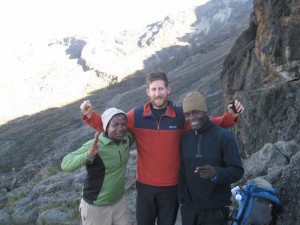 Having come on my lonesome I was paired with Michael and his daughter Therese; they were Swedish. Our guides Dulla and Silvano talked us through the first few days of the trip, watch outs, warnings, dos and don’ts. I received a new name, too, they both had difficulty pronouncing Simon so I was christened Solomon, a name I grew quite fond of.
Having come on my lonesome I was paired with Michael and his daughter Therese; they were Swedish. Our guides Dulla and Silvano talked us through the first few days of the trip, watch outs, warnings, dos and don’ts. I received a new name, too, they both had difficulty pronouncing Simon so I was christened Solomon, a name I grew quite fond of.
Briefing over and one last dinner. Unfortunately I got stuck opposite a lady who had returned after only three days into her trek following acute mountain sickness. She kindly told me it was worse than giving birth, the last thing I wanted to hear.
The Trek
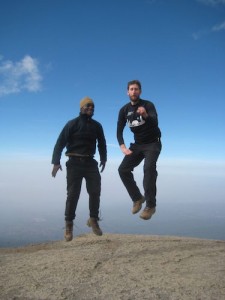 The next morning it was an early start and an hour drive to Machame Gate, the starting point for my seven day trek.
The next morning it was an early start and an hour drive to Machame Gate, the starting point for my seven day trek.
The first day, an eight hour walk through the jungle, went without a hitch. Regular breaks for food and drink were imperative. As was ensuring our walking pace was super slow. Dulla and Silvano ensured we walked ‘pole pole’ – slowly slowly in Swahili.
Having reached our first camp at 3000m it became very clear very quickly that a positive approach to each day was imperative because you’d wake each morning not knowing whether this was your last day on the mountain. Was mountain sickness going to hit and ruin your trip? Overcoming headaches and feelings of sickness was a small battle that needed to be won each day.
For the next five days our routine of walk, sleep and eat wouldn’t alter. Michael, Therese, Trevor and Marco – two South African guys – and I kept each other motivated when one was struggling.
Days would range between four to nine hours of walking, getting closer to the summit with each step. Temperatures would vary throughout, during the day you might only need a couple of layers top and bottom but at night temperatures would drop to way below zero and four to five layers were essential inside the sleeping bag.
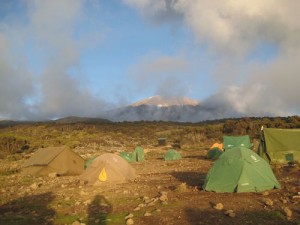 It’s worth noting that each person wasn’t just support by a chief guide, there were five other people in your support team; a cook, a waiter who brought you three full meals each day – I had chicken and chips at 4600m one day – and three porters who carried all of your kit and their own, too.
It’s worth noting that each person wasn’t just support by a chief guide, there were five other people in your support team; a cook, a waiter who brought you three full meals each day – I had chicken and chips at 4600m one day – and three porters who carried all of your kit and their own, too.
To me every one of them was a superhero. Each morning you’d be greeted with a personal alarm call and a three course breakfast before setting off. An hour into the walk and some 300 porters would come marching past carrying up to 40kgs of kit on their head, neck or back. When you reached the next camp at the end of the day your tent would be set up with bag and sleeping bag set out. They really did do everything in their power to get us up the mountain.
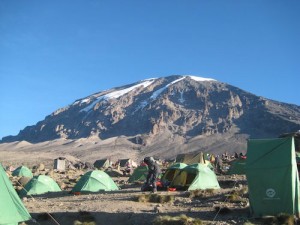 After five days I reached base camp at 4600m. This was the final stop before our ascent to the summit. Until then each day had passed without any real drama. I’d spent most of the time in awe of my surroundings and had truly relished every minute. That was until summit night.
After five days I reached base camp at 4600m. This was the final stop before our ascent to the summit. Until then each day had passed without any real drama. I’d spent most of the time in awe of my surroundings and had truly relished every minute. That was until summit night.
The Summit
The days before this meant nothing, if I didn’t make it up the mountain it had all been in vain. Failure was not an option.
The alarm went off at 11.15pm then a quick breakfast before setting off at 12.10pm. It was unbelievably cold. Thankfully the four layers I was wearing on my bottom half, five on top plus gloves, a balaclava and hat kept me warm.
Dressed and resembling The Michelin Man, Dulla and I began the final ascent.
It was a steep start and at 4800 metres was hard to catch your breath despite walking at an incredibly slow pace. After a short time the heart rate settled and I found a steady rhythm.
About an hour in and I felt very sick and began to worry. Another hour passed and temperatures were dropping to minus 10 but fortunately the nausea subsided. Relief!
As the next few hours passed the route to the summit resembled a war zone; collapsed bodies, people being carried, on emergency oxygen and vomiting but I kept going.
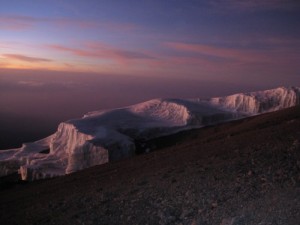 Four hours in and I was starting to hit the wall and hallucinate; things were appearing in the sky and on the rocks that hadn’t been there before. There was about an hour to go until Stellar Point – a key landmark on the summit – but I wasn’t sure I’d get there.
Four hours in and I was starting to hit the wall and hallucinate; things were appearing in the sky and on the rocks that hadn’t been there before. There was about an hour to go until Stellar Point – a key landmark on the summit – but I wasn’t sure I’d get there.
Calling upon all my reserves, physical and mental, I was within five minutes of reaching Stellar Point. When Dulla told me that I knew I was going to make it and got a second wind.
They were the longest five minutes of my life but I reached the landmark. I broke down, utterly exhausted I couldn’t control my emotions. I’d pushed myself to the limit.
There was still 45 minutes to go, though, but I’d overcome the hardest part. I knew I was going to make it now. Dulla and I had made such good time that I reached Uhuru Peak – the highest point in Africa – first and in darkness.
It was so cold – my trousers had frozen by this point – that we spent five minutes there for a few quick photos with my Pancreatic Cancer UK t-shirt before marching down the mountain with the biggest spring in my step. I’d bloody done it!
The Summary
Would I recommend the trip? In a heartbeat! But to say it was a life changing experience is too cliché it was, however, the most memorable, incredible, inspiring, challenging, stunning (insert any joyful adjective here) 10 days of my life.
What I do hope, though, is the £5k plus money I’ve raised (donations are still coming in) can in some way help the fight against Pancreatic Cancer and there are more people celebrating their five year anniversary like Lynne.


1 Comment. Leave new
Amazing read mate! What an achievement and for a great cause.
Ps the comment form at the bottom is confusing so if my name email and comments are in the wrong place that’s why.